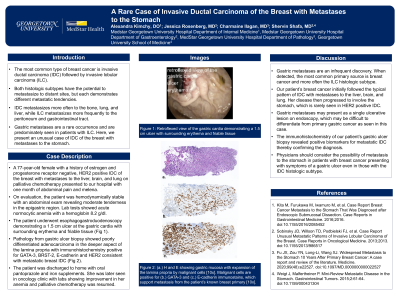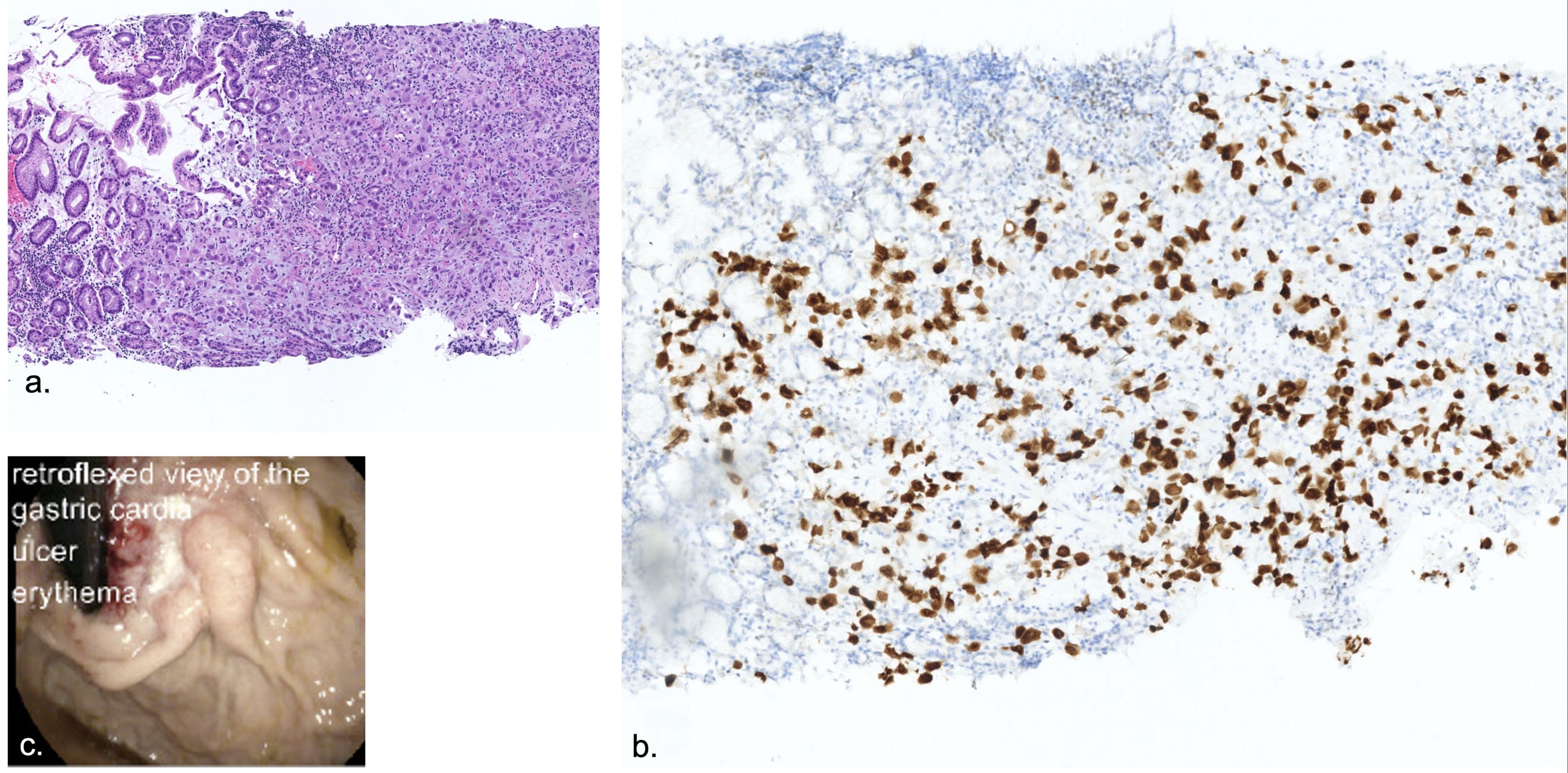Back


Poster Session C - Monday Afternoon
Category: Stomach
C0725 - A Rare Case of Invasive Ductal Carcinoma of the Breast With Metastases to the Stomach
Monday, October 24, 2022
3:00 PM – 5:00 PM ET
Location: Crown Ballroom

Has Audio

Alexandra Kimchy, DO
MedStar Georgetown University Hospital
Washington, DC
Presenting Author(s)
Alexandra Kimchy, DO, Jessica Rosenberg, MD, Charmaine Ilagan, MD, Shervin Shafa, MD
MedStar Georgetown University Hospital, Washington, DC
Introduction: The most common type of breast cancer is invasive ductal carcinoma (IDC) followed by invasive lobular carcinoma (ILC). Both histologic subtypes have the potential to metastasize to distant sites, but each demonstrates different metastatic tendencies. IDC metastasizes more often to the bone, lung, and liver, while ILC metastasizes more frequently to the peritoneum and gastrointestinal tract. Gastric metastases are a rare occurrence and are predominately seen in patients with ILC. Here, we present an unusual case of IDC of the breast with metastases to the stomach.
Case Description/Methods: A 77-year-old female with a history of estrogen and progesterone receptor negative, HER2 positive IDC of the breast with metastases to the liver, brain, and lung on palliative chemotherapy presented to our hospital with one month of abdominal pain and melena. On evaluation, the patient was hemodynamically stable with an abdominal exam revealing moderate tenderness in the epigastric region. Lab tests showed acute normocytic anemia with a hemoglobin 8.2 g/dl. The patient underwent esophagogastroduodenoscopy demonstrating a 1.5 cm ulcer at the gastric cardia with surrounding erythema and friable tissue. Pathology from gastric ulcer biopsy showed poorly differentiated adenocarcinoma in the deeper aspect of the lamina propria with immunohistochemistry positive for GATA-3, BRST-2, E-cadherin and HER2 consistent with metastatic breast IDC. The patient was discharged to home with oral pantoprazole and iron supplements. She was later seen in oncology clinic with labs showing improvement in her anemia and palliative chemotherapy was resumed.
Discussion: Gastric metastases are an infrequent discovery. When detected, the most common primary source is breast cancer and more often the ILC histologic subtype. Our patient’s breast cancer initially followed the typical pattern of IDC with metastases to the liver, brain, and lung. Her disease then progressed to involve the stomach, which is rarely seen in HER2 positive IDC. Gastric metastases may present as a single ulcerative lesion on endoscopy, which may be difficult to differentiate from primary gastric cancer as seen in this case. The immunohistochemistry of our patient’s gastric ulcer biopsy revealed positive biomarkers for metastatic IDC thereby confirming the diagnosis. Physicians should consider the possibility of metastasis to the stomach in patients with breast cancer presenting with symptoms of a gastric ulcer even in those with the IDC histologic subtype.

Disclosures:
Alexandra Kimchy, DO, Jessica Rosenberg, MD, Charmaine Ilagan, MD, Shervin Shafa, MD. C0725 - A Rare Case of Invasive Ductal Carcinoma of the Breast With Metastases to the Stomach, ACG 2022 Annual Scientific Meeting Abstracts. Charlotte, NC: American College of Gastroenterology.
MedStar Georgetown University Hospital, Washington, DC
Introduction: The most common type of breast cancer is invasive ductal carcinoma (IDC) followed by invasive lobular carcinoma (ILC). Both histologic subtypes have the potential to metastasize to distant sites, but each demonstrates different metastatic tendencies. IDC metastasizes more often to the bone, lung, and liver, while ILC metastasizes more frequently to the peritoneum and gastrointestinal tract. Gastric metastases are a rare occurrence and are predominately seen in patients with ILC. Here, we present an unusual case of IDC of the breast with metastases to the stomach.
Case Description/Methods: A 77-year-old female with a history of estrogen and progesterone receptor negative, HER2 positive IDC of the breast with metastases to the liver, brain, and lung on palliative chemotherapy presented to our hospital with one month of abdominal pain and melena. On evaluation, the patient was hemodynamically stable with an abdominal exam revealing moderate tenderness in the epigastric region. Lab tests showed acute normocytic anemia with a hemoglobin 8.2 g/dl. The patient underwent esophagogastroduodenoscopy demonstrating a 1.5 cm ulcer at the gastric cardia with surrounding erythema and friable tissue. Pathology from gastric ulcer biopsy showed poorly differentiated adenocarcinoma in the deeper aspect of the lamina propria with immunohistochemistry positive for GATA-3, BRST-2, E-cadherin and HER2 consistent with metastatic breast IDC. The patient was discharged to home with oral pantoprazole and iron supplements. She was later seen in oncology clinic with labs showing improvement in her anemia and palliative chemotherapy was resumed.
Discussion: Gastric metastases are an infrequent discovery. When detected, the most common primary source is breast cancer and more often the ILC histologic subtype. Our patient’s breast cancer initially followed the typical pattern of IDC with metastases to the liver, brain, and lung. Her disease then progressed to involve the stomach, which is rarely seen in HER2 positive IDC. Gastric metastases may present as a single ulcerative lesion on endoscopy, which may be difficult to differentiate from primary gastric cancer as seen in this case. The immunohistochemistry of our patient’s gastric ulcer biopsy revealed positive biomarkers for metastatic IDC thereby confirming the diagnosis. Physicians should consider the possibility of metastasis to the stomach in patients with breast cancer presenting with symptoms of a gastric ulcer even in those with the IDC histologic subtype.

Figure: Figure 1: [A] H and E shows gastric mucosa with expansion of the lamina propria by malignant cells (10x). [B] The malignant cells are positive for GATA-3 immunostain which supports metastasis from patient’s known breast primary (10x). [C] 1.5 cm ulcer at the gastric cardia with surrounding erythema and friable tissue.
Disclosures:
Alexandra Kimchy indicated no relevant financial relationships.
Jessica Rosenberg indicated no relevant financial relationships.
Charmaine Ilagan indicated no relevant financial relationships.
Shervin Shafa: Pentax America – Consultant.
Alexandra Kimchy, DO, Jessica Rosenberg, MD, Charmaine Ilagan, MD, Shervin Shafa, MD. C0725 - A Rare Case of Invasive Ductal Carcinoma of the Breast With Metastases to the Stomach, ACG 2022 Annual Scientific Meeting Abstracts. Charlotte, NC: American College of Gastroenterology.
